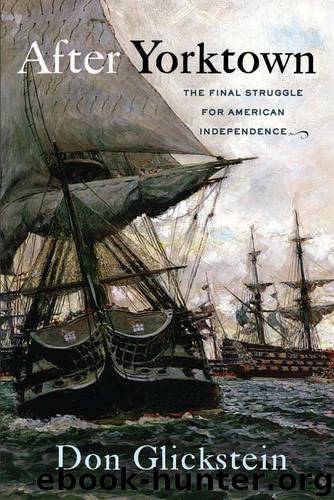After Yorktown by Don Glickstein

Author:Don Glickstein
Language: eng
Format: azw3, epub
ISBN: 9781594166037
Publisher: Westholme Publishing
Published: 2015-11-11T05:00:00+00:00
Settlers took years to discover that rice was an ideal crop for the Carolinas and Georgia. The Caribbean experience was different. Columbus brought nonindigenous sugar cane there on his second voyage in 1493. He expected it to grow well, and it did. By 1506, sugar had become an industry, and Spain built its first sugar-refining mill. Within a decade, Spain used African slaves in the mills and fields.10
The West Indies attracted other Europeans, first pirates, then settlers and traders. For three centuries, they raided or invaded each other’s islands, ceded them at the end of wars, then reinvaded when new wars began. When France entered the American war in 1778, the West Indies was a checkerboard of nations. Britain, France, and Spain owned the best sugar-growing islands; the Dutch and Danes turned their less productive islands into trading centers. Despite Spanish dominance and anger, British and Dutch settlers formed villages on the coastal mainlands of Central and northern South America. Although Britain could do only minor ship repairs in Jamaica, the French had four ports capable of major refitting, while Spain owned Havana, which had shipbuilding yards.11
None of these countries could resist sugar’s lure, nor its by-products, molasses and rum. In 1698, the British imported 207 gallons of rum; by 1775, it was two million. Europeans used sugar in everything from tea and coffee to jam, and the British used sugar more than anyone. The French, with a lesser sweet tooth, captured the sugar market on the European continent.12
The sugar colonies meant wealth for the largely absentee plantation owners who grew it and for the governments that taxed it. “The sugar colonies possessed by the European nations in the West Indies, may be compared to those precious vineyards,” Adam Smith wrote. Another contemporary described Jamaica as the source of “prodigious riches.” In fact, Jamaica was the wealthiest British colony in the Western Hemisphere.13
The French made even more money from their Caribbean colonies. In negotiations to end the Seven Years’ War in 1763, France didn’t hesitate to trade all of Canada (minus a fishing village off the Newfoundland coast) for Martinique, Guadeloupe, and St. Lucia. Spain swapped Florida and nearly all territory east of the Mississippi for Cuba. The final treaty caused an uproar in London; most British felt they got the short straw.14
France knew what it was doing. The Caribbean trade accounted for thirty percent of its imports and, because none of its islands were self-sufficient, thirty-five percent of its exports. Its Saint-Domingue colony (now Haiti) was the most valuable land on earth. It produced more and cheaper sugar than all British Caribbean islands combined. Saint-Domingue’s trade was greater than that of the British North American colonies combined. The West Indies accounted for one-third of all French trade overseas.15
“The profits of a sugar plantation in any of our West Indian colonies are generally much greater than those of any other cultivation that is known either in Europe or America,” Adam Smith said.16
George III was blunt: “If we lose our sugar islands, it will be impossible to raise money to continue the war.
Download
This site does not store any files on its server. We only index and link to content provided by other sites. Please contact the content providers to delete copyright contents if any and email us, we'll remove relevant links or contents immediately.
| Africa | Americas |
| Arctic & Antarctica | Asia |
| Australia & Oceania | Europe |
| Middle East | Russia |
| United States | World |
| Ancient Civilizations | Military |
| Historical Study & Educational Resources |
In Cold Blood by Truman Capote(3140)
Steve Jobs by Walter Isaacson(2766)
The Innovators: How a Group of Hackers, Geniuses, and Geeks Created the Digital Revolution by Walter Isaacson(2512)
All the President's Men by Carl Bernstein & Bob Woodward(2267)
Lonely Planet New York City by Lonely Planet(2108)
The Room Where It Happened by John Bolton;(2034)
And the Band Played On by Randy Shilts(2019)
The Murder of Marilyn Monroe by Jay Margolis(1984)
The Poisoner's Handbook by Deborah Blum(1983)
The Innovators by Walter Isaacson(1974)
Lincoln by David Herbert Donald(1874)
A Colony in a Nation by Chris Hayes(1797)
Under the Banner of Heaven: A Story of Violent Faith by Jon Krakauer(1687)
Amelia Earhart by Doris L. Rich(1588)
The Unsettlers by Mark Sundeen(1586)
Birdmen by Lawrence Goldstone(1536)
Dirt by Bill Buford(1523)
Zeitoun by Dave Eggers(1519)
Decision Points by George W. Bush(1466)
